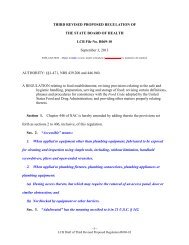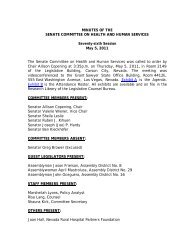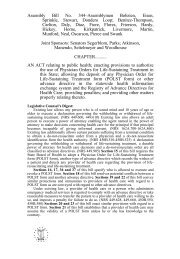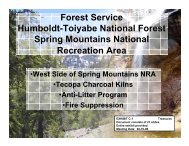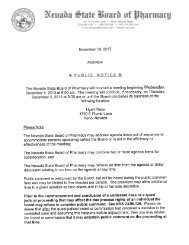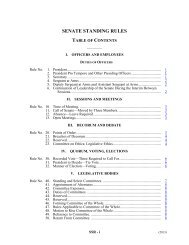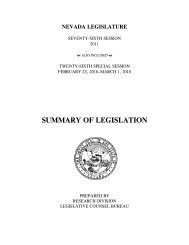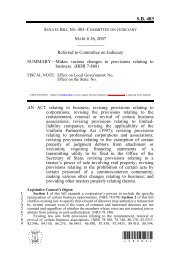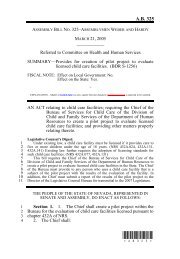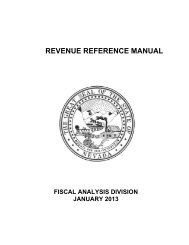Nevada Pre-Kindergarten Standards
Nevada Pre-Kindergarten Standards
Nevada Pre-Kindergarten Standards
Create successful ePaper yourself
Turn your PDF publications into a flip-book with our unique Google optimized e-Paper software.
Content Standard 7.0: Listening<br />
Indicator LS = Listening<br />
7.PK.1a Listen for a variety of purposes with increasing<br />
attention span.<br />
7.PK.1b Listen to and follow a two-step oral<br />
direction with the use of formal and informal language.<br />
7.K.1 Listen for a variety of purposes, including<br />
gaining information, being entertained and understanding<br />
directions. With assistance, listen for and identify main idea,<br />
purpose and messages.<br />
7.PK.2 Listen and respond appropriately to stories<br />
and group discussions.<br />
7.K.2 Listen to and respond to oral communication.<br />
7.PK.3 Listen with increasing attention span to gain<br />
new vocabulary.<br />
7.K.3 Expand vocabulary through listening.<br />
7.PK.5 Engage in conversation and sometimes follow<br />
conversational rules.<br />
7.K.5 Actively listen to a speaker; listen to and participate in<br />
conversations.<br />
Content Standard 8.0: Speaking<br />
Indicator S= Speaking<br />
8.PK.1 Speak with increasing clarity, ease and accuracy,<br />
and give clear directions.<br />
8.K.1 With assistance, give directions to complete tasks;<br />
ask questions to clarify directions.<br />
Language<br />
Examples: Children will/may...<br />
Listen to teachers, children, and book<br />
recordings in listening centers.<br />
Listen for instructions or ideas in order<br />
to complete tasks.<br />
Demonstrate through actions their<br />
understanding of directions or requests.<br />
Repeat instructions and/or assist other<br />
children with completing directions.<br />
Ask why, who, what, when, where, and how<br />
when listening to conversations or to books<br />
read aloud.<br />
Repeat rhymes, songs, or passages in<br />
books.<br />
Answer questions related to books.<br />
Ask questions about stories indicating<br />
increased attention to details.<br />
Model developmentally appropriate behaviors<br />
when listening to others speak or read.<br />
Demonstrate an understanding of changes<br />
in routine or of changes in words from<br />
books.<br />
Begin to demonstrate an understanding<br />
of turn-taking in conversation.<br />
Participate as an equal partner in<br />
conversations with others.<br />
Examples: Children will/may...<br />
Communicate effectively in native<br />
language (e.g., English, Spanish, or sign).<br />
Supportive Practice: Practitioner/Adult will…<br />
Listen to children without interruption.<br />
Ask children to repeat or rephrase<br />
statements made by others.<br />
Model asking and answering questions.<br />
Provide time for child-initiated discussions<br />
on topics that interest children.<br />
Use storytelling to encourage the use of<br />
new and interesting words.<br />
Ask many open-ended questions.<br />
Help the children understand directions by<br />
encouraging them to repeat them to other<br />
children or adults.<br />
Discuss topics that are relevant and<br />
interesting to children.<br />
Introduce topics that children can<br />
expand and explore further.<br />
Encourage “good listening ears,” and<br />
developmentally appropriate “listening”<br />
behavior.<br />
Provide children with experiences to learn<br />
the nuances of conversation (e.g., pausing<br />
and waiting to respond to a question or<br />
taking turns).<br />
Supportive Practice: Practitioner/Adult will…<br />
Respond to language and help clarify<br />
children’s meanings.<br />
Answer children’s questions about words<br />
and meanings.<br />
39



